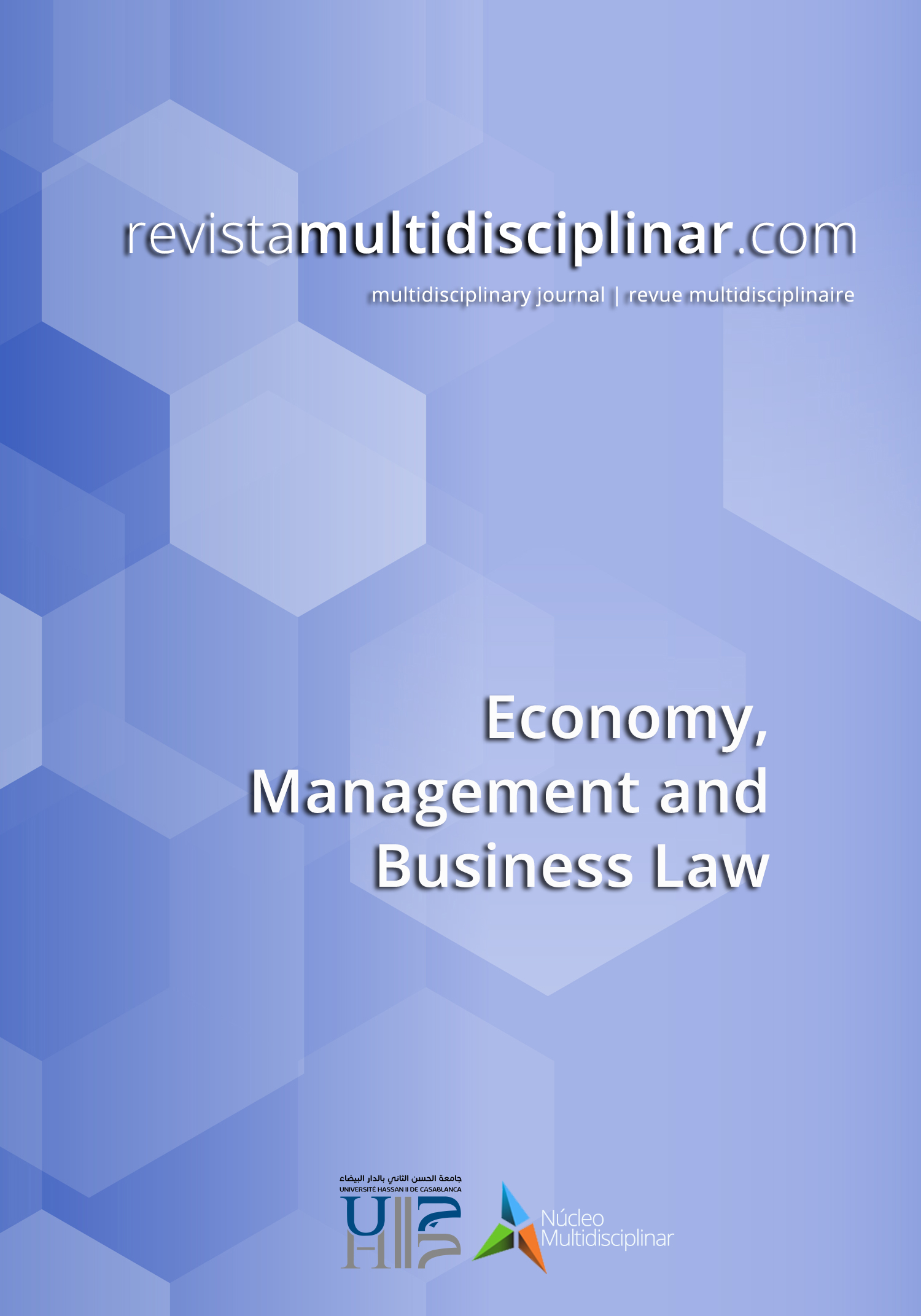Um estudo sobre a eficácia do desenvolvimento financeiro no crescimento económico de Marrocos
DOI:
https://doi.org/10.23882/rmd.24201Palavras-chave:
crescimento económico, desenvolvimento financeiro, crédito privado à economia, VECMResumo
As teorias do crescimento económico sugerem que um sector financeiro desenvolvido pode promover o crescimento da economia. No entanto, a capacidade do sector financeiro para impulsionar o crescimento económico depende da sua capacidade de financiar a economia.
Este documento investiga a relação entre o crescimento económico de Marrocos e o desenvolvimento financeiro (DF). Baseamos o nosso estudo no papel crucial do sector bancário no crescimento económico dos países em desenvolvimento através da sua intermediação financeira. Para verificar esta relação, é utilizado o modelo vetorial de correção de erros (VECM) com base em dados secundários: PIB real per capita (PIB) e um conjunto de variáveis explicativas que representam o sector do desenvolvimento financeiro, especificamente o rácio do crédito ao sector privado (CPS) e variáveis de controlo, incluindo a percentagem do consumo público (PC), a taxa de juro real (IR), a abertura comercial (TO) e a taxa de inflação (INF). Os nossos dados secundários provêm da base de dados do Banco Central de Marrocos e abrangem 56 trimestres de 2007T1 a 2020T4. Os resultados confirmam os benefícios a longo e a curto prazo do desenvolvimento do sector financeiro para o crescimento económico em Marrocos.
Palavras-chave: crescimento económico, desenvolvimento financeiro, crédito privado à economia, modelo vetorial de correção de erros (VECM), Marrocos.
Referências
Abu-Bader, S., & Abu-Qarn, A. S. (2008). Financial development and economic growth: The Egyptian experience. Journal of Policy Modeling, 30(5), 887-898.
Alagidede, P., & Ibrahim, M. (2017). On the causes and effects of exchange rate volatility on economic growth: Evidence from Ghana. Journal of African Business, 18(2), 169-193.
Allen, D. S., & Ndikumana, L. (2000). Financial intermediation and economic growth in Southern Africa. Journal of African economies, 9(2), 132-160.
Beck, T., Demirgüç-Kunt, A., & Levine, R. (2010). Financial institutions and markets across countries and over time: The updated financial development and structure database. The World Bank Economic Review, 24(1), 77-92.
Bencivenga, V. R., & Smith, B. D. (1991). Financial intermediation and endogenous growth. The review of economic studies, 58(2), 195-209.
Blackburn, K., & Hung, V. T. (1998). A theory of growth, financial development and trade. Economica, 65(257), 107-124.
Bose, N., & Cothren, R. (1996). Equilibrium loan contracts and endogenous growth in the presence of asymmetric information. Journal of Monetary Economics, 38(2), 363-376.
Boyd, J., & Smith, B. (1996). The coevolution of the real and financial sectors in the growth process. The World Bank Economic Review, 10(2), 371-396.
Chen, H. (2006). Development of financial intermediation and economic growth: The Chinese experience. China Economic Review, 17(4), 347-362.
Christopoulos, D. K., & Tsionas, E. G. (2004). Financial development and economic growth: evidence from panel unit root and cointegration tests. Journal of development Economics, 73(1), 55-74.
De Kroon, H., Van Groenendael, J., & Ehrlén, J. (2000). Elasticities: a review of methods and model limitations. Ecology, 81(3), 607-618.
Greenwood, J., & Jovanovic, B. (1990). Financial development, growth, and the distribution of income. Journal of political Economy, 98(5, Part 1), 1076-1107.
Gries, T., Kraft, M., & Meierrieks, D. (2009). Linkages between financial deepening, trade openness, and economic development: causality evidence from Sub-Saharan Africa. World development, 37(12), 1849-1860.
Gurley, J. G., & Shaw, E. S. (1967). Financial structure and economic development. Economic development and cultural change, 15(3), 257-268.
Hasan, H. (2018). Relationship between financial development and economic growth: Empirical evidence in Indonesia. International Journal of Economics and Finance, 10(12), 37-42.
Ibrahim, M., & Alagidede, P. (2017). Financial Development, Growth Volatility and Information Asymmetry in Sub‐Saharan Africa: Does Law Matter? South African Journal of Economics, 85(4), 570-588.
Kar, M., Nazlıoğlu, Ş., & Ağır, H. (2011). Financial development and economic growth nexus in the MENA countries: Bootstrap panel granger causality analysis. Economic modelling, 28(1-2), 685-693.
King, R. G., & Levine, R. (1993). Finance and growth: Schumpeter might be right. The quarterly journal of economics, 108(3), 717-737.
Levine, R. (1997). Financial development and economic growth: views and agenda. Journal of economic literature, 35(2), 688-726.
Levine, R., Loayza, N., & Beck, T. (2000). Financial intermediation and growth: Causality and causes. Journal of monetary Economics, 46(1), 31-77.
Lütkepohl, H. (2005). New Introduction to Multiple Time Series Analysis. Berlin: Springer-Verlag
McKinnon, R. I. (1991). Financial control in the transition from classical socialism to a market economy. Journal of Economic Perspectives, 5(4), 107-122.
McKinnon, Ronald I., (1973). Money and Capital i n Economic Development (Washington, DC: Brookings Institution).
Pagano, M. (1993). Financial markets and growth: an overview. European economic review, 37(2-3), 613-622.
Pagano, M., & Jappelli, T. (1993). Information sharing in credit markets. The journal of finance, 48(5), 1693-1718.
Schumpeter, J., & Backhaus, U. (2003). The theory of economic development. In Joseph Alois Schumpeter (pp. 61-116). Springer, Boston, MA.
Schumpeter, Joseph A., (1911). The Theory of Economic Development (Cambridge, M A : Harvard Uniyyrsity Press.
Seven, Ü., & Yetkiner, H. (2016). Financial intermediation and economic growth: Does income matter?. Economic Systems, 40(1), 39-58.
Shittu, A. I. (2012). Financial intermediation and economic growth in Nigeria. British Journal of Arts and Social Sciences, 4(2), 164-179.
Downloads
Publicado
Como Citar
Edição
Secção
Licença
Direitos de Autor (c) 2024 Rachida EL YAMANI

Este trabalho encontra-se publicado com a Creative Commons Atribuição-NãoComercial 4.0.







